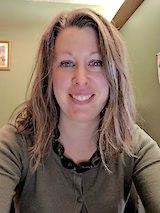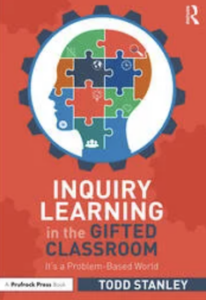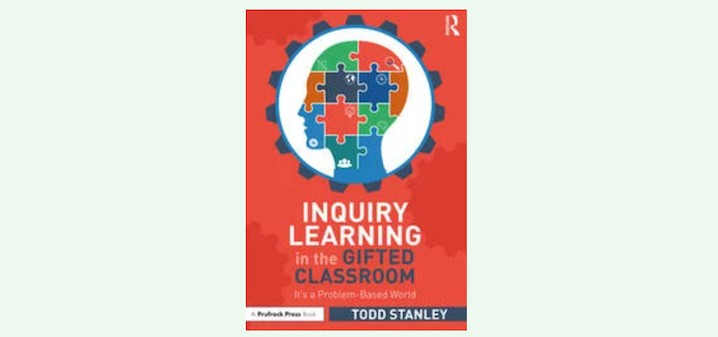Inquiry Learning in the Gifted Classroom: It’s a Problem-Based World
By Todd Stanley
(Routledge/Prufrock Press, 2023 – Learn more)
Reviewed by Kim Rensch

 A few years ago I found myself teaching two middle school language arts enrichment classes. Coming off the pandemic, my eighth grade students struggled to attend and find any sort of intrinsic motivation for engaging in the learning.
A few years ago I found myself teaching two middle school language arts enrichment classes. Coming off the pandemic, my eighth grade students struggled to attend and find any sort of intrinsic motivation for engaging in the learning.
Out of sheer desperation, I threw out all my carefully crafted units and tossed out a question to my students: If you could improve one thing about our city, what would it be, and how would you address the problem?
Those questions probably saved my sanity that year, as students finally took the wheel of their own learning. While the project sparked student engagement, the process was not without its hiccups. It would have helped to have had Todd Stanley’s book Inquiry Learning in the Gifted Classroom: It’s a Problem-Based World to guide me during that time.

 As with most things in education, project-based learning had its time in the spotlight, took a back seat to other initiatives for a while, and is now looking to make a comeback…sort of. This time it is project-based learning’s mischievous sibling, problem-based learning, that is gaining traction in the educational spotlight.
As with most things in education, project-based learning had its time in the spotlight, took a back seat to other initiatives for a while, and is now looking to make a comeback…sort of. This time it is project-based learning’s mischievous sibling, problem-based learning, that is gaining traction in the educational spotlight.
Problem-based learning (PrBL) has quite a champion in author and gifted and talented coordinator Todd Stanley, who writes prolifically about inquiry-based learning models. Any educator looking to adopt problem-based learning will find Stanley’s book, Inquiry Learning in the Gifted Classroom: It’s a Problem-Based World, to be a thorough explanation of the topic.
The Setup
Stanley opens the book with a brief introduction where he contends that problems confront us every day; therefore, learning skills for tackling problems should be a large part of what students do in school. Next comes chapter 1, where readers learn just what problem-based learning is and how it differs from case-based and project-based learning.
It takes six pages to get to the definition of PrBL, as the goal of the first six pages is to explain the differences between problem-based learning and other inquiry-based learning models. As a result, readers should move on from the first chapter with a good understanding of what problem-based learning is:
“a student-centered approach in which students learn about a subject by working in groups to solve an open-ended problem” (12).
Stanley offers examples to illustrate his explanation of PrBL, including a useful table showing how simple tweaks to learning tasks can turn a traditional lesson into one that is inquiry-based. After chapter 2’s devotion to the rationale for PrBL, the remaining chapters take educators through the nuts and bolts of adopting problem-based learning.
In a sort of “practice what I preach” move, Stanley begins chapters with a problem and ends them with a task related to the chapter’s topic. For example, the end of chapter 3 tasks readers with taking “a lesson that you already do and see how you can fit it into the steps of PrBL” (38). Educators who go through these tasks will likely end the reading experience with some clarity about the next steps to take toward implementation of problem-based learning.
Assessment: How This Book Stands Out from Other PrBL Texts
Stanley attempts to preempt any obstacles standing in the way of educators committing to problem-based learning by addressing assessment and grading of PrBL units head on.
Where other books give grading a cursory mention, Stanley devotes an entire chapter to the how of grading and assessing problem-based units. One particular strength is how he addresses some limitations and offers solutions. His graphic organizer to track observations of student mastery makes note collection less wieldy, for example.
If I could give Stanley a suggestion for making this chapter even stronger, it would be to attend to the growing number of teachers who use standards-based grading practices. Readers whose districts require standards-based grading will have to spend more time sifting through the ideas in this chapter and finding innovative ways to capture mastery of standards.
Stanley suggests using student reflection as a means of assessment, offering up several ways of collecting reflections, like double-entry journals and reflective essays. These reflections could be vehicles for collecting student content knowledge for standards-based graders, but it does add a level of complexity to grading that teachers using the traditional grading system might not face. Despite this extra burden of complexity, this chapter offers a wealth of creative and useful methods of assessment not always found in books on this topic.
Another chapter that makes this book stand apart is called “The Power of Reflection.” The author contends that because “PrBL is all about process and experience” (99), reflection is “a supplement that you take in order to make the learning even stronger” (98). This chapter offers lists of follow-up questions students could address, tips for nurturing a culture that values reflection, and protocols to guide student reflection.
A Warning to Readers and Final Thoughts
The former English teacher in me feels it prudent to warn readers that occasional sloppy punctuation errors might prove distracting. But for any educator looking to engage students through inquiry-based units, these distractions are not enough to take away from Stanley’s thorough treatment of the problem-based learning model. It is a well-organized, approachable book for teachers looking to shake up the learning experience for themselves and their students.
Kim Rensch is a National Board Certified Teacher and former middle school language arts teacher working as the lead facilitator of the Gifted Services team for Fargo Public Schools in North Dakota. She is a board member for the North Dakota Association for Gifted Children. When she is not advocating for gifted children, Kim can be found at church, digging around the garden, or on walking trails with her husband and dogs.
Project-based learning’s mischievous sibling, problem-based learning, is gaining traction in the educational spotlight. Kim Rensch, lead facilitator of her district’s gifted services team, reports Todd Stanley’s book goes deep into assessment after a thorough look at PrBL.








